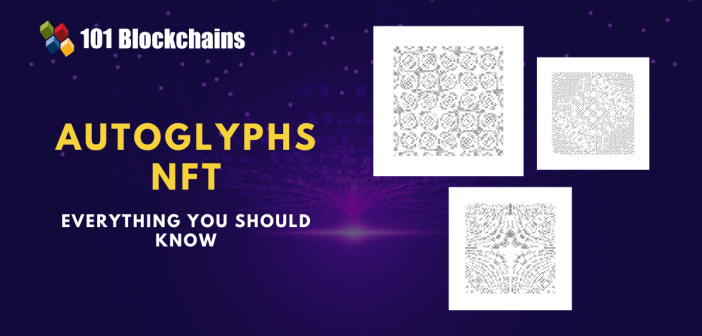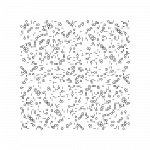Learn how blockchain truly works, master key definitions, and uncover what makes smart contracts so "smart." Dive into the fundamentals, gain valuable insights, and start your blockchain journey today!

- Guides
Georgia Weston
- on April 12, 2022
Autoglyphs NFT – A Detailed Guide
Wondering what is Autoglyphs in NFT? Well, It’s an NFT project by Larva Labs. Dive in to learn more about the Autoghyphs NFT!
Change is inevitable, and we have been learning this fact time and again with every new development in technology. The world has witnessed the arrival of many revolutionary offshoots of modern technology in the last decade. For example, blockchain and cryptocurrencies are two top names that show how technology induces large-scale changes.
Today, the popularity of NFTs has got everyone talking about Autoglyphs NFT, the second project by CryptoPunks creators, Larva Labs. Many people interested in the NFT space want to know about Autoglyphs and their special highlights. The following discussion offers an introductory guide on Autoglyphs with answers to many common questions regarding them.
Aspiring to Become a Certified NFT Expert? Enroll in Certified NFT Professional (CNFTP) Course Now!
Background of Autoglyphs
The foremost topic in any discussion around Autoglyphs would obviously focus on their definition. Before you find the answer to “What is Autoglyphs NFT?” you need to know that the generative art movement has been around since the 1960s. Generative art basically involves the creation of a process that, when set in motion, results in a complete artwork.
On the other hand, blockchain technology and NFTs have changed the way artists create and share their artwork with buyers. Many on-chain generative art projects have successfully capitalized on the NFT market boom and fetched some of the most amazing prices. Autoglyphs NFT evolved as the first on-chain generative art collection in 2019 and has spurred many other additions in generative art projects.
Want to get an in-depth understanding of non-fungible tokens (NFTs)? Enroll Now in NFT Fundamentals Course
What is Autoglyphs?

The background of Autoglyphs shows that they are an innovative project in the field of on-chain generative art. However, you must understand them beyond the simple definition of Autoglyphs. In the technical sense, Autoglyphs generative art basically refers to a highly optimized generative algorithm. The algorithm, wrapped in an ERC-721 interface, can help in creating multiple unique artworks.
You shall reflect more on the technical details of Autoglyphs later in this discussion. For now, you can think of Autoglyphs as the first on-chain generative art project based on the Ethereum blockchain. Interestingly, they offer a comprehensively self-contained mechanism for creating and exercising ownership over generative art.
Learn the basic and advanced concepts of ethereum technology? Enroll Now in The Complete Ethereum Technology Course
Who Created Autoglyphs?
Another notable aspect in any discussion about Autoglyphs NFT would focus on the creators of the on-chain generative art project. The developers of Autoglyphs are none other than Larva Labs, the founder of CryptoPunks and Meebits. Autoglyphs is the second project of Larva Labs after CryptoPunks. The Canadian software developers behind Larva Labs, John Watkinson and Matt Hall, laid the foundations of Autoglyphs.
Interestingly, the creators of Autoglyphs have come up with Meebits; an exclusive project focused on entering the metaverse. The two prominent individuals behind “Who made Autoglyphs?” follow the vision of using blockchain to resolve various issues in the future. As a matter of fact, Autoglyphs serve reliable proof of the commitment of Larva Labs to develop projects aligning with the technological parameters of the future.
Start learning NFT with World’s first NFT Skill Path
Technical Foundation of Autoglyphs
The overview of the definition of Autoglyphs, alongside the identity and objectives of their founders, sets the stage for discussing their technical foundation. The Autoglyphs NFT is an algorithm based on the ERC-721 standard, generally followed for non-fungible tokens. However, ERC-721 focuses on managing ownership of digital assets stored off the chain. On the contrary, Autoglyphs is considerably different as the artwork created by the algorithm is in the contract itself. Therefore, the artwork generated by Autoglyphs remains on the blockchain rather than in any off-chain storage.
Autoglyphs represents an interesting experiment in the field of generative art by incorporating the functionalities of blockchain technology. All Autoglyphs generative art pieces are unique and developed by code on the Ethereum blockchain. Created originally in 2019, Autoglyphs helped anyone interested in creating the glyphs and storing the artwork on the blockchain. At the time of its launch, you had to pay the minting fee of 0.2 ETH to the charity organization 350.org. The charity organization uses the minting fee for fighting against climate change alongside promoting clean and renewable energy generation.
Get familiar with the terms related to non-fungible token with Non-Fungible Token Flashcards
How Are Autoglyphs Created?
As you can notice, Autoglyphs NFT is a unique and innovative project in comparison to other NFT projects. The arrival of Autoglyphs enabled a new revolution in on-chain generative art projects by facilitating the storage of artwork on the blockchain itself. On the other hand, many of you must have some doubts regarding the creation of Autoglyphs.
First of all, you need to understand that Autoglyphs can create generative art by using algorithms. Each artwork is wrapped with an ERC-721 interface working as an NFT token, with the original data of the artwork. Therefore, the artwork stays in the smart contract, which in turn stays on the blockchain, thereby ensuring that the artwork stays permanently on the blockchain.
While you may have discovered promising answers to “What is Autoglyphs?” alongside their work, it is important to note other details. One of the significant highlights of creating Autoglyphs is that the algorithm has been programmed for creating limited Autoglyphs. As a result, the art generator has stopped automatically after creating 512 Autoglyphs. It also means that you cannot mint any more Autoglyphs.
However, you can purchase existing Autoglyphs on OpenSea and other secondary marketplaces. Interestingly, the generating code for Autoglyphs alongside their ownership details are available to the public now. Therefore, the transparency regarding Autoglyphs also provides promising assurance for security and authenticity in digital artworks. With the help of the ERC-721 standard, Autoglyphs can validate the identity of rightful owners alongside storing data on the blockchain.
Build your identity as a certified blockchain expert with 101 Blockchains’ Blockchain Certifications designed to provide enhanced career prospects.
Other Significant Details about Autoglyphs
The identity of Autoglyphs generative art project shows the opportunities for generative art in the form of NFTs. If you thought you knew all about the basics of Autoglyphs, then you need to think again. Here are some of the interesting facts about Autoglyphs, which you should know before trying them out.
The original code for generating Autoglyphs NFT is compact and optimized for execution on Ethereum nodes. Since the code is available to the public on Larva Labs website, anyone can review it.
You can also render the Autoglyphs in physical form as Larva Labs uses a CNC plotter for the same. Therefore, you can get real-life renderings of Autoglyphs, which you can see on the website. You can create the SVGs tailored particularly for use with CNC plotters. Users have to access the details page of a specific glyph and prove their ownership for accessing the functionality.
Autoglyphs generative art is practically ASCII art if you look closely at their design. The developers have created a custom font for rendering the raw text in the glyphs directly. You can discover the complete range of font weights from 100 to 900 varying in terms of texture thickness.
Another innovative implication with Autoglyphs is that you can turn them into generative music. Autoglyphs owners can access this functionality through the detail pages of the Autoglyphs after cryptographically proving the ownership of the glyphs. The feature of turning Autoglyphs NFT into generative music works better with the combination of multiple glyphs.
Get familiar with the terms related to ethereum technology with Ethereum Flashcards
What’s So Special about Autoglyphs?
Autoglyphs are indeed an innovative experiment in on-chain data, and it has proved successful. The fact that all the Autoglyphs sold within 4 hours of their launch clearly speaks of the hype around them. Today, you cannot mint Autoglyphs anymore as all the 512 Autoglyphs have already been created. As of now, 152 different owners have the 512 Autoglyphs. You can find Autoglyphs on OpenSea for sale at different prices depending on their rarity. How does this make Autoglyphs any different from the other NFT projects such as CryptoPunks or CryptoKitties?
The biggest highlight of Autoglyphs is that traditional NFTs store the actual image files in an off-chain database. Artists have to use a link to the image from the blockchain with a hash, which can enable the location of the image file. Therefore, the actual artwork does not receive any advantages of immutability and decentralization associated with blockchain technology.
If you look at it from another perspective, anyone could change, remove or transfer the actual artwork from the location to which a blockchain hash points. Autoglyphs NFT offers an improvement by storing the artwork on the blockchain itself. The developers used small and efficient code for Autoglyphs, which stays on the blockchain.
Interestingly, owners can ask the blockchain for rendering the Autoglyphs again as it happens on an end node without any additional costs. The blockchain does not feature the image data and has an ASCII art representation of the glyphs.
Final Words
The final impression about Autoglyphs generative art projects suggests a promising future for generative NFT art projects. Autoglyphs challenged the status quo of conventional NFTs, which store the actual artwork in an off-chain database. With the help of a generative algorithm, the platform enabled users to create and store glyphs on the Ethereum blockchain.
However, the developers limited the generative algorithm to creating only 512 Autoglyphs. If you want to get one, then you can find Autoglyphs on OpenSea, the most popular NFT marketplace. Autoglyphs have successfully opened new routes for creating inspired artworks with better advantages of blockchain technology. Start learning more about Autoglyphs right now.
*Disclaimer: The article should not be taken as, and is not intended to provide any investment advice. Claims made in this article do not constitute investment advice and should not be taken as such. 101 Blockchains shall not be responsible for any loss sustained by any person who relies on this article. Do your own research!





